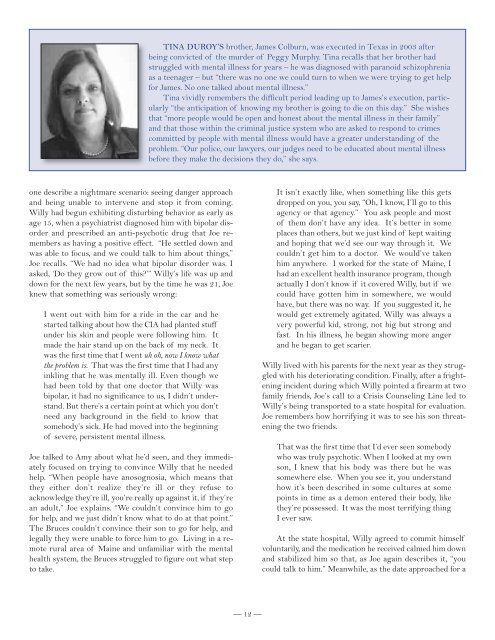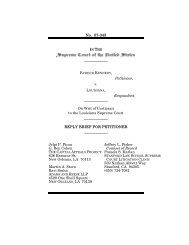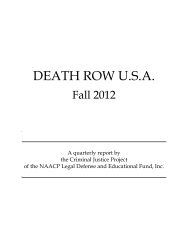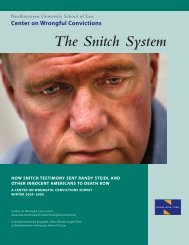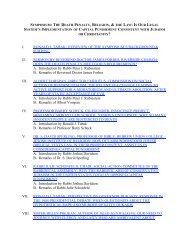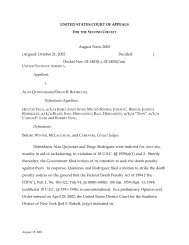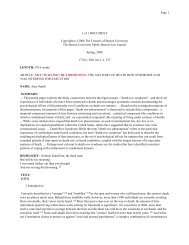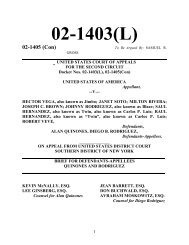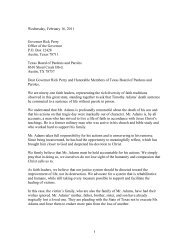Double Tragedies - Families for Human Rights
Double Tragedies - Families for Human Rights
Double Tragedies - Families for Human Rights
- No tags were found...
You also want an ePaper? Increase the reach of your titles
YUMPU automatically turns print PDFs into web optimized ePapers that Google loves.
TINA DUROY’S brother, James Colburn, was executed in Texas in 2003 afterbeing convicted of the murder of Peggy Murphy. Tina recalls that her brother hadstruggled with mental illness <strong>for</strong> years – he was diagnosed with paranoid schizophreniaas a teenager – but “there was no one we could turn to when we were trying to get help<strong>for</strong> James. No one talked about mental illness.”Tina vividly remembers the difficult period leading up to James’s execution, particularly“the anticipation of knowing my brother is going to die on this day.” She wishesthat “more people would be open and honest about the mental illness in their family”and that those within the criminal justice system who are asked to respond to crimescommitted by people with mental illness would have a greater understanding of theproblem. “Our police, our lawyers, our judges need to be educated about mental illnessbe<strong>for</strong>e they make the decisions they do,” she says.one describe a nightmare scenario: seeing danger approachand being unable to intervene and stop it from coming.Willy had begun exhibiting disturbing behavior as early asage 15, when a psychiatrist diagnosed him with bipolar disorderand prescribed an anti-psychotic drug that Joe remembersas having a positive effect. “He settled down andwas able to focus, and we could talk to him about things,”Joe recalls. “We had no idea what bipolar disorder was. Iasked, ‘Do they grow out of this?’” Willy’s life was up anddown <strong>for</strong> the next few years, but by the time he was 21, Joeknew that something was seriously wrong:I went out with him <strong>for</strong> a ride in the car and hestarted talking about how the CIA had planted stuffunder his skin and people were following him. Itmade the hair stand up on the back of my neck. Itwas the first time that I went uh oh, now I know whatthe problem is. That was the first time that I had anyinkling that he was mentally ill. Even though wehad been told by that one doctor that Willy wasbipolar, it had no significance to us, I didn’t understand.But there’s a certain point at which you don’tneed any background in the field to know thatsomebody’s sick. He had moved into the beginningof severe, persistent mental illness.Joe talked to Amy about what he’d seen, and they immediatelyfocused on trying to convince Willy that he neededhelp. “When people have anosognosia, which means thatthey either don’t realize they’re ill or they refuse toacknowledge they’re ill, you’re really up against it, if they’rean adult,” Joe explains. “We couldn’t convince him to go<strong>for</strong> help, and we just didn’t know what to do at that point.”The Bruces couldn’t convince their son to go <strong>for</strong> help, andlegally they were unable to <strong>for</strong>ce him to go. Living in a remoterural area of Maine and unfamiliar with the mentalhealth system, the Bruces struggled to figure out what stepto take.It isn’t exactly like, when something like this getsdropped on you, you say, “Oh, I know, I’ll go to thisagency or that agency.” You ask people and mostof them don’t have any idea. It’s better in someplaces than others, but we just kind of kept waitingand hoping that we’d see our way through it. Wecouldn’t get him to a doctor. We would’ve takenhim anywhere. I worked <strong>for</strong> the state of Maine, Ihad an excellent health insurance program, thoughactually I don’t know if it covered Willy, but if wecould have gotten him in somewhere, we wouldhave, but there was no way. If you suggested it, hewould get extremely agitated. Willy was always avery powerful kid, strong, not big but strong andfast. In his illness, he began showing more angerand he began to get scarier.Willy lived with his parents <strong>for</strong> the next year as they struggledwith his deteriorating condition. Finally, after a frighteningincident during which Willy pointed a firearm at twofamily friends, Joe’s call to a Crisis Counseling Line led toWilly’s being transported to a state hospital <strong>for</strong> evaluation.Joe remembers how horrifying it was to see his son threateningthe two friends.That was the first time that I’d ever seen somebodywho was truly psychotic. When I looked at my ownson, I knew that his body was there but he wassomewhere else. When you see it, you understandhow it’s been described in some cultures at somepoints in time as a demon entered their body, likethey’re possessed. It was the most terrifying thingI ever saw.At the state hospital, Willy agreed to commit himselfvoluntarily, and the medication he received calmed him downand stabilized him so that, as Joe again describes it, “youcould talk to him.” Meanwhile, as the date approached <strong>for</strong> a__ 12 __


